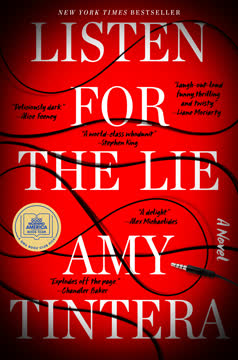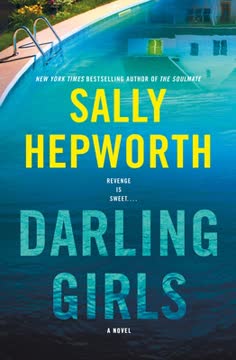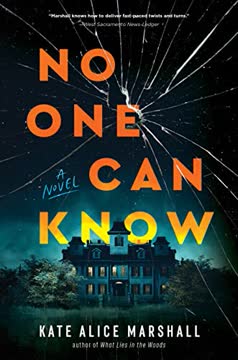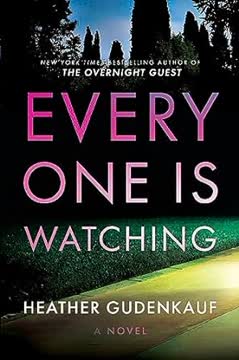Plot Summary
The Game Begins
Amy Whey's quiet suburban life is upended when a mysterious new neighbor, Roux, crashes her book club. What starts as a playful evening among mothers quickly turns tense when Roux introduces a twisted version of "Never Have I Ever," a game that demands confessions of the worst things each woman has done. The game's sharp edge is aimed directly at Amy, who feels the weight of her own hidden past. As the women drink and play, secrets begin to surface, and Amy senses that Roux's arrival is no accident. The night ends with Amy rattled, Roux's intentions unclear, and the first cracks appearing in the safe, ordinary world Amy has built.
Roux's Arrival
Roux, beautiful and enigmatic, inserts herself into Amy's neighborhood and social circle with calculated charm. She quickly becomes the center of attention, drawing out the insecurities and rivalries among the women. Amy is both fascinated and unsettled by Roux's confidence and her ability to manipulate the group dynamic. Roux's presence exposes the fragility of suburban harmony, and Amy's unease grows as she realizes Roux is watching her closely. The sense of threat is subtle but unmistakable, and Amy's instincts tell her that Roux is here for a reason—one that has everything to do with Amy's own carefully concealed history.
Secrets and Confessions
As Roux's game escalates, the women's confessions grow darker, and Amy is forced to confront memories she has long suppressed. The tension between Amy and Roux intensifies, with Roux hinting that she knows more about Amy than she should. Amy's anxiety mounts as she tries to protect her family and friendships from the fallout of old mistakes. The game becomes a psychological battle, with Roux probing for weaknesses and Amy struggling to maintain control. The emotional stakes rise, and Amy realizes that the secrets she thought were buried may soon be exposed, endangering everything she loves.
Amy's Buried Past
Amy's teenage years are revealed in painful detail: a reckless night with her friend Tig leads to a car crash that kills a neighbor, Mrs. Shipley. Amy survives, but the trauma and guilt haunt her into adulthood. The legal aftermath is shaped by privilege and silence—Amy's wealthy family hires a top lawyer, and Tig, from a poorer background, takes the blame and serves time. Amy's mother insists on secrecy, and Amy learns to compartmentalize her guilt, building a new life far from her past. But the memory of that night, and the knowledge that she let someone else pay for her crime, never truly leaves her.
The Reckoning Night
Roux confronts Amy privately, revealing that she knows about the accident and Amy's role in it. She claims to have witnessed Amy driving and accuses her of letting Tig go to prison in her place. Roux demands that Amy "make it up" to her, hinting at blackmail. The confrontation is intimate and chilling, with Roux holding Amy's darkest secret over her head. Amy is shaken to her core, realizing that her past is no longer safe. The power dynamic shifts—Roux is in control, and Amy is forced to consider how far she will go to protect her family and her new life.
Blackmail Unveiled
Roux's demands become explicit: she wants a large sum of money from Amy, threatening to expose her secret if she refuses. Amy scrambles to understand Roux's motives and background, suspecting that Roux is running from her own troubles. The psychological warfare intensifies as Amy tries to buy time, seeking ways to turn the tables. She investigates Roux's past, enlists the help of old friends, and weighs the cost of confession versus capitulation. The stakes are raised—not just for Amy, but for her best friend Charlotte, whose own marriage is unraveling under the strain of neighborhood secrets.
The Price of Silence
Amy's relationship with Charlotte deepens as Charlotte faces betrayal in her own marriage. Amy is torn between her loyalty to Charlotte and her need to keep her own secret. The emotional toll of the blackmail grows heavier, and Amy is forced to confront the true cost of silence—not just for herself, but for those she loves. The lines between victim and perpetrator blur, and Amy must decide what kind of person she wants to be. The pressure mounts as Roux's deadline approaches, and Amy realizes that there may be no way out that doesn't involve sacrifice.
Charlotte's Friendship
Charlotte, unaware of Amy's secret, becomes her anchor and confidante. Their friendship is a source of strength, but also a reminder of the damage Amy's past has caused. Charlotte's own struggles—with a cheating husband and the demands of motherhood—mirror Amy's internal battles. The two women support each other through crisis, but Amy's guilt over her hidden history with Charlotte's family (the Shipley connection) intensifies. The emotional complexity of their bond is tested as Roux's threats loom, and Amy is forced to reckon with the possibility of losing her closest friend.
The Past Resurfaces
Amy's investigation into Roux's background leads her to shocking discoveries. She learns that Roux is not who she claims to be, and that her own past is more entangled with the present than she realized. The search for leverage becomes a race against time, as Amy uncovers evidence of Roux's crimes and the true nature of her relationship with her son, Luca. The emotional stakes are heightened by the reappearance of Tig, Amy's old friend and the scapegoat of her past. The past and present collide, forcing Amy to confront the full consequences of her actions.
The Search for Roux
As Roux's threats escalate, Amy is pushed to her limits. She breaks into Roux's house, searching for evidence that can free her from the blackmail. The discovery of multiple fake identities, a gun, and disturbing clues about Roux's relationship with Luca raises the stakes. Amy is forced to make impossible choices, balancing her own safety, her family's future, and the well-being of a vulnerable child. The tension reaches a breaking point as Amy realizes that the only way to end Roux's game may be to expose her, no matter the personal cost.
Playing to Win
Amy and Roux engage in a final psychological showdown, each trying to outmaneuver the other. Amy leverages what she has learned about Roux's past, threatening to reveal her crimes if Roux doesn't back down. The confrontation is fraught with danger, as both women are pushed to the edge. Amy's resolve is tested, and she must decide whether to become the kind of person she has always feared—or to find another way. The game that began as a party trick becomes a fight for survival, with everything on the line.
The Truth About Luca
Amy discovers that Luca is not Roux's biological son, but a missing teenager named Ezra, abducted from his real mother. The truth about Roux's predatory relationship with Luca comes to light, and Amy is horrified by the depth of Roux's manipulation and abuse. Amy contacts Luca's real mother, setting in motion a rescue operation. The emotional impact is devastating, as Amy realizes the extent of the damage Roux has caused—not just to her, but to everyone around her. The stakes are no longer just personal; they are a matter of life and safety for a child.
Betrayal and Bargains
The final confrontation between Amy and Roux is explosive. Roux, desperate and armed, tries to flee with Luca. Amy intervenes, risking her own life to stop them. The struggle is physical and brutal, culminating in Amy shooting Roux in self-defense. The aftermath is chaotic—police arrive, Luca is rescued, and Amy is left to face the consequences of her actions. The emotional toll is immense, but Amy is also freed from Roux's hold. The cost of survival is high, and Amy must reckon with the choices she has made.
The Dive and the Storm
In the wake of the confrontation, Amy recovers physically and emotionally. She supports Charlotte through her divorce, helps Luca (Ezra) reunite with his real family, and begins to rebuild her own life. The neighborhood is changed, but Amy finds solace in her family, her friendship with Charlotte, and the peace she finds in diving. The experience has transformed her, forcing her to confront her past and accept responsibility for her actions. The storm has passed, but the lessons remain, shaping the person Amy is becoming.
The Final Confrontation
Amy faces the aftermath of Roux's death and the exposure of her own secrets. She must navigate the fallout with her family, friends, and community. The process is painful, but also redemptive. Amy learns to forgive herself, to accept the love and support of those around her, and to let go of the guilt that has defined her for so long. The journey is not easy, but it is necessary. Amy emerges stronger, wiser, and more at peace with herself and her past.
Aftermath and Reckoning
The story concludes with Amy finding a measure of peace. She continues to support Charlotte, helps her own family heal, and maintains a connection with Luca's real mother. The neighborhood moves on, changed but resilient. Amy's journey is one of self-discovery, atonement, and the search for forgiveness. The scars of the past remain, but they no longer define her. Amy has learned that true strength comes from facing the truth, making amends, and choosing to live with integrity, no matter the cost.
Letting Go
In the final moments, Amy returns to the water, the place where she finds solace and clarity. She reflects on the journey she has taken—the mistakes, the pain, the love, and the redemption. The ocean becomes a metaphor for forgiveness and renewal, a place where the past can be released and the future embraced. Amy lets go of her guilt, her fear, and her need for control, choosing instead to live fully in the present. The story ends with hope, as Amy looks forward to a life defined not by secrets, but by honesty, courage, and love.
Characters
Amy Whey
Amy is the protagonist, a suburban mother and wife whose seemingly ordinary life is built on a foundation of guilt and secrecy. As a teenager, she caused a fatal accident and allowed her friend Tig to take the blame, shaping her adult life with shame and self-doubt. Amy is fiercely loyal, especially to her best friend Charlotte, and deeply protective of her family. Her psychological complexity is rooted in her struggle to reconcile her past with her present, and her journey is one of atonement, self-forgiveness, and the search for integrity. Amy's development is marked by her willingness to confront her darkest truths and to fight for those she loves, even at great personal cost.
Angelica Roux (Roux)
Roux is the antagonist, a beautiful, enigmatic woman who arrives in Amy's neighborhood with a hidden agenda. She is a master of psychological games, using charm, intimidation, and blackmail to get what she wants. Roux's motivations are complex—she is driven by desperation, a need for control, and a warped sense of justice. Her relationship with her "son" Luca is deeply troubling, revealing her as both abuser and victim. Roux's psychological profile is marked by narcissism, cunning, and a capacity for cruelty, but also by vulnerability and pain. Her presence forces Amy and the other characters to confront their own secrets and moral boundaries.
Charlotte Baxter (Char)
Charlotte is Amy's best friend and emotional anchor, a kind-hearted, organized, and nurturing woman. She is the glue that holds the neighborhood together, but her own life is far from perfect—her marriage is troubled, and she carries the scars of a difficult childhood. Unbeknownst to her, Charlotte is connected to Amy's past in a profound way, as the daughter of the woman killed in Amy's accident. Charlotte's development is shaped by betrayal, loss, and the strength she finds in her friendships. Her relationship with Amy is central to the story, embodying themes of forgiveness, trust, and the complexity of human connection.
Luca / Ezra Wheeler
Luca, introduced as Roux's teenage son, is later revealed to be Ezra Wheeler, a missing child abducted from his real mother. He is intelligent, sensitive, and deeply affected by the trauma of his situation. Luca's relationship with Roux is fraught with confusion, loyalty, and abuse. His interactions with Amy and Maddy highlight his longing for normalcy and safety. Luca's psychological journey is one of survival, resilience, and the hope for rescue and healing. His presence in the story raises the stakes and exposes the true extent of Roux's predatory nature.
Tig Simms
Tig is Amy's childhood friend and the boy who took the blame for the accident that defined her life. He is resourceful, loyal, and marked by his own struggles with guilt and lost potential. Tig's relationship with Amy is complex—rooted in shared trauma, unspoken love, and the pain of betrayal. His reappearance in Amy's life forces her to confront the truth about her past and the consequences of her actions. Tig represents both what Amy has lost and what she might still recover through honesty and courage.
Davis Whey
Davis is Amy's husband, a stable, principled man who values honesty and order. He is a loving father to Maddy and Oliver, and his relationship with Amy is built on trust and mutual respect. Davis's psychological role is that of anchor and conscience, challenging Amy to live up to her own ideals. His reactions to the unfolding drama are measured and compassionate, providing a counterpoint to the chaos introduced by Roux. Davis's presence grounds the story in the realities of family, responsibility, and the possibility of forgiveness.
Madison "Maddy" Whey
Maddy is Amy's stepdaughter, a bright, creative, and emotionally complex teenager. She is navigating the challenges of adolescence, identity, and first love, particularly in her relationship with Luca. Maddy's bond with Amy is strong, but tested by secrets and the dangers that enter their lives. Her psychological journey mirrors Amy's in many ways, as she learns about trust, boundaries, and the importance of self-respect. Maddy's experiences serve as a catalyst for Amy's growth and the story's exploration of generational cycles of trauma and healing.
Phillip Baxter
Phillip is Charlotte's husband, whose infidelity and emotional distance contribute to the unraveling of their marriage. He is self-absorbed, entitled, and ultimately abandons Charlotte and their children. Phillip's actions serve as a parallel to Amy's own betrayals, highlighting themes of loyalty, trust, and the consequences of selfishness. His character is less developed than others, but his impact on Charlotte and the neighborhood is significant, driving key plot developments and emotional arcs.
Panda Grier
Panda is a secondary character whose own hidden life is exposed by Roux's manipulations. She is vulnerable, anxious, and desperate to protect her marriage and reputation. Panda's interactions with Roux and the other women illustrate the pervasive power of secrets and the ways in which shame and fear can be weaponized. Her character adds depth to the story's exploration of community, judgment, and the costs of conformity.
Faith Wheeler
Faith is the biological mother of Luca/Ezra, a woman devastated by her son's disappearance. Her determination, love, and eventual reunion with her child provide a counterpoint to the darkness of Roux's actions. Faith's presence in the story underscores themes of maternal love, resilience, and the possibility of redemption. Her psychological strength and vulnerability highlight the stakes of the narrative and the importance of fighting for what is right.
Plot Devices
The Game as Catalyst
The novel's central plot device is the twisted version of "Never Have I Ever" introduced by Roux. What begins as a social icebreaker quickly morphs into a tool for manipulation, confession, and blackmail. The game structure allows for the gradual revelation of secrets, escalating tension, and shifting power dynamics. It serves as both a literal and metaphorical device, exposing the hidden truths that define the characters' lives and relationships. The game's rounds mirror the stages of psychological and moral reckoning, driving the narrative toward its explosive climax.
Dual Timelines and Flashbacks
The story employs a dual timeline, with flashbacks to Amy's teenage years and the accident that haunts her. These interludes provide crucial context, deepening the reader's understanding of Amy's guilt, motivations, and the forces that shaped her. The interplay between past and present creates suspense, foreshadows key revelations, and underscores the theme that the past is never truly buried. The structure allows for gradual disclosure, maintaining narrative tension and emotional resonance.
Unreliable Narration and Psychological Depth
Amy's perspective is deeply subjective, colored by guilt, fear, and self-doubt. The narrative often withholds information, creating suspense and inviting the reader to question what is real and what is rationalization. This unreliable narration heightens the psychological complexity of the story, blurring the lines between victim and perpetrator, right and wrong. The device is used to explore themes of self-deception, confession, and the difficulty of true atonement.
Foreshadowing and Symbolism
The recurring motif of water and diving serves as both literal setting and symbolic framework. The ocean represents both danger and healing, a place where secrets can be submerged and, ultimately, released. Amy's relationship with diving mirrors her psychological journey—seeking peace, confronting fear, and learning to let go. The motif is woven throughout the narrative, foreshadowing key events and providing a metaphor for forgiveness, renewal, and the possibility of redemption.
Blackmail and Moral Dilemmas
The plot is driven by the escalating blackmail scheme orchestrated by Roux. The device forces Amy to confront impossible choices—between confession and silence, loyalty and self-preservation, justice and survival. The moral dilemmas are heightened by the presence of vulnerable characters (Charlotte, Luca, Maddy), making every decision fraught with consequence. The device is used to explore the limits of forgiveness, the cost of secrets, and the nature of true courage.
Analysis
Never Have I Ever is a masterful psychological thriller that interrogates the nature of guilt, confession, and the high cost of secrets. Through the lens of a suburban mother's unraveling, the novel explores how the past can haunt the present, and how the desire for redemption can lead to both healing and destruction. The story's central game is a metaphor for the ways we test the boundaries of honesty, loyalty, and self-knowledge. Jackson's narrative structure—blending suspense, character study, and social commentary—invites readers to question the stories we tell ourselves and the price we pay for silence. The novel's ultimate lesson is that true strength lies not in perfection, but in the willingness to face our darkest truths, make amends, and choose love and integrity, even when the cost is high. In a world where everyone has something to hide, Never Have I Ever is a powerful meditation on forgiveness, the complexity of human connection, and the courage it takes to let go and begin again.
Last updated:
Review Summary
Never Have I Ever is a suspenseful thriller about Amy, whose peaceful life is disrupted when Roux, a mysterious newcomer, threatens to expose her dark past. The book begins with a tense book club meeting and evolves into a dangerous game of cat-and-mouse. Readers praised Jackson's compelling characters, unexpected twists, and addictive storytelling. While some found the pacing slow at times, many appreciated the complex moral dilemmas and shocking revelations. The novel's exploration of secrets, redemption, and the lengths one will go to protect their life garnered mostly positive reviews.
Similar Books
Download PDF
Download EPUB
.epub digital book format is ideal for reading ebooks on phones, tablets, and e-readers.















